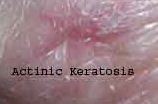Pictures, Causes and Treatment for Spots on Skin
Table of Contents
Overview
Identifying the reason for spots on skin can be difficult since there are at least 61 conditions, diseases, viruses, bacteria and infections that can result in skin spots. Clues are provided by location and appearance such as color, shape and if the area is raised.
Descriptions and skin spot pictures are provided below for problems such as white skin spots, red skin spots and many other common conditions.
The guiding principle at all times is to call your doctor if you do not know where the spots came from and if they do not go away within three or so days. If you’re not sure about any curious spots, discoloration or other related symptoms, don’t wait until the problem
gets worse, particularly if the any skin growth changes in size, color or starts to bleed.
There are well over 61 causes for spots on skin, which you may find overwhelming. We are going to list some of the more common causes, instead of all 61 causes, largely because many of them are the exception, rather than the rule.
Usually, the doctor only needs to see how your skin looks. However, there are a number of conditions that also “look alike” and they may want to do a skin biopsy or skin bacterial culture. Your doctor may want to conduct microscopic skin and fungal tests, depending on what disease s/he feels you may have. Skin biopsies will help rule out other possible conditions when the doctor is trying to provide you with a diagnosis.
There are numerous treatments for spots on skin. While many of these treatments do mention conventional medicines, you may wish to check out natural remedies; easily found on the Internet. As always, use caution when you read about alternative treatments and therapies.
Causes by Color
A skin spots color and location can often indicate the type of skin condition. Here are some common skin conditions and their related skin spot color:
Spots on skin caused by raised small lesions:
| Color | Possible Causes |
| Dull Red | Psoriasis (rarely on face, often seen on nails) |
| Pinkish Yellow | Pityriasis
Rosea (rarely on face) Seborrheic Dermatitis (appears greasy, commonly on face) |
| Reddish Brown | Tinea Versicolor (occasionally on face) |
| Violaceous (violet) | Lichen Planus (rarely on face and nails) |
| Pink or Red | Hemangiomas Keloids |
Spots on skin caused by benign tumors and change in pigmentation by color
| Color | Possible Causes |
| Pink or Red | Acne Hemangiomas Herpes Simplex: viral infection  Red Skin Spots Caused by Herpes Virus Source: AAD Keloid Skin Allergy |
| Brown or dark spots |
Seborrheic
Keratoses (horny growth) Picture of Seborrhoeic Keratoses (not harmful) Nevi (birthmarks and moles)  Picture of a Harmless Mole Characteristics of harmless moles are:
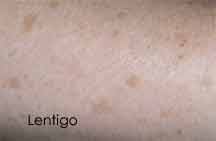 Age Spots are not a health risk, are flat, and occur as the result of cumulative exposure to the sun Source: The Meisenheimer Clinic Dermatofibromas |
| Tannish Yellow | Xanthomata
: tumor made up of lipid cells Xanthelasma: skin gorwth that appears on the eyelids comprised of lipits or fitty skin Warts Keloids: skin overgrowth tthat occurs after injury |
| Dark blue or tan | Seborrheic
Keratoses Hemangioma Blue Nevi Dermatofibroma |
| Black |
Moles Sun Spots Melanoma (skin cancer) Riehl melanoisis (pigment on face and neck) Erythromelanosis follicarlis Lineafusca |
White Spots on Skin
A common complaint is the appearance of white spots on skin. Potential causes include:
- Vitiglio: Skin condition where the skin loses pigment or color.
- Fungus (e.g; tinea versicolor)- A fungal infection can cause white spots on areas such as the back and chest. An athletes foot or jock itch cream could be of some help. Fungus can also be contracted from tanning beds.
- Idiopathic Guttate Hypomelanosis (IGH): the result of sun exposure
- Skin damage from the sun
- Hereditary condition
- Pityriasis Alba
- Post inflammatory hypopigmentation: caused when a previous skin condition heals, leaving behind white skin spots or marks.
Skin Spots on the Face
Most causes of spots on face are harmless. They can be a variety of colors including white, red, black or brown. Common causes include cumulative sun exposure, acne, and skin tags.
Keratoacanthoma (hyperkeratosis) is a lesion that grows rapidly, usually on areas exposed to the sun. Lesions are shaped like a dome and are usually red to tan/brown. Treatment is with surgical. removal. Can also be treated with topicals. It can destroy skin tissue in areas where the tumor grows. The condition is considered to be related to squamous cell carcinoma, although a biopsy is needed to determine if the condition is cancerous in nature.

Hyperkeratosis or Keratoacanthoma goes through multiple stages of growth. Because of this, treatment is early in the tumors evolution.
Any face lesions should be differentiated from cancerous conditions such as basal cell carcinoma, the most common form of cancer in people. The condition primarily occurs in men (but can occur in women) over age 40. It is very rare in people that have black or brown skin. Skin tumors are slow growing and can cause bleeding.
Treatment involves surgical removal, electrodesiccation, and cryosurgery.

Basal Cell Carcinoma is the most common form of cancer in people. The small size shown is indicative of the early stages of the condition.
Causes, Symptoms & Treatment
Here's a list of the most common conditions, causes and treatment options. Conventional treatment options and homeopathic alternatives are listed where available. If you don't see improvement after trying non-prescription options be sure to see a Doctor, particularly if you see changes in size, shape and color.
| Spots on Skin Conditions |
Cause | Symptoms | Treatment |
| Acne | Inflamed skin sebaceous glands | Back,
face or chest, shoulders, neck dotted with small, pus-filled
pimple-like
bumps, blackheads, whiteheads, pimples or sore, red bumps. Source: Principles of Pediatric Dermatology |
Over the counter (OTC) medications such as benzoyl peroxide and/or natural acne treatments to start. If this doesn’t work, see your doctor. Wash using mild soap regularly. May need prescription medicines. |
| Actinic keratoses | Prolonged sun exposure | Tan,
gray or pink patches/bumps on the backs of
your hands, your face or scalp. |
See your doctor, as this condition may lead to skin cancer. Your doctor will choose the most appropriate treatment |
| Allergic contact dermatitis | Occurs when skin comes in contact with an irritant or a substance that causes an allergic reaction | itchy
red rash in any location
on your body, with blisters beginning to form after coming into contact
with something that your skin is allergic to.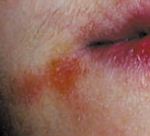 Source: Principles of Pediatric Dermatology |
keep area clean with soap and water. Symptoms should vanish within a week. If not and to relieve itching, use calamine lotion, natural remedies or hydro-cortisone cream. See doctor if rash covers whole body, you have blisters or have trouble breathing and have swelling or a fever |
| Allergic purpura | Blood diseases that cause bleeding under the skin | Small
red dots in various locations on your skin,
or larger, almost bruise-like areas that came up after taking medication Source: Principles of Pediatric Dermatology |
See doctor immediately. Discontinue medication |
| Allergy reaction | Sensitivity to substances such as food, medications and environmental irritants | Flat,
raised or irregular raised sores that come up after taking a medication
or in response to something in the environment Penicillin Skin Allergy Reaction Source: CDC |
Antihistamine for itching and rash. If you have difficulty breathing, red and itchy bumps on your skin, dizziness or nausea, go to the ER |
| Boil or carbuncle | Pull filled skin inflammation. A carbuncle is a collection of boils | Red,
angry looking sores on any location of your
body. More than one boil is a carbuncle, caused by infection under the
skin Source: Principles
of Pediatric Dermatology
|
Warm compresses and homeopathic remedies such as Boil-Rx. Antibiotic ointments if required. If boils don’t head out, call the doctor. |
| Bullous Pemphigoid | Autoimmune disease in older people | Blisters on the
surface of the skin Bullous Pemphigoid on Hand Source: Northwestern University |
Topical corticosteroids |
| Cellulites | Inflamed skin tissue or inflammation of the connective tissue | Very
tender, flushed red and swollen areas of skin
around a cut or scrape Cellulites Picture Source: Principles of Pediatric Dermatology |
Clean area with soap/water, apply antibiotic ointment. If pain and redness spreads, call doctor |
| Chickenpox | Varicella-zoster virus | Cough,
fever, sore throat, fatigue, many blisters on
chest, face, back and neck that spread downward Chicken Pox Picture on Child Source: CDC/Dr. John Noble, Jr. |
Supportive care with acetaminophen, anti-itching creams, cool compresses, cold medications and baths |
| Cradle cap | Flaking of the scalp in babies | Typical
with children, and the scalp is dry, scaly, itchy, greasy and sometimes
yellowish Cradle Cap Picture Source: Principles of Pediatric Dermatology |
Gently scrub scales to remove them. Hydrocortisone cream. or a natural remedy such as Cradle Clear. See your doctor if the rash doesn't improve |
| Dermatitis herpetiformis | Gluten sensitivity | Insanely
itching red rash that breaks out
in bumps and blisters. Typically on buttocks, knees and elbows.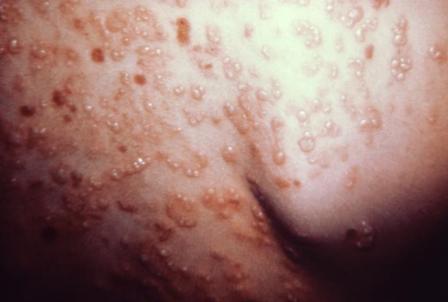 Dermatitis Herpetiformis in 4 yr. old child Source: CDC |
Antibiotics may be used to control symptoms. Don’t eat foods that contain gluten. |
| Erythema multiforme | Caused by medications such as Penicillin, aspirin and some drugs used for epilepsy | A blotchy, patchy,
red rash, with sores or
hives that look like a target Source: ADPE
|
Common rash caused by strep, viral infections and reactions to medicines. See your doctor for the treatment of choice |
| Erythema nodosum | Caused by several diseases such as tuberculosis, fungal infections in the lungs, IBD (inflammatory bowel disease), leprosy.. Can also be caused by medications such as birth control pills, penicillin and sulfonamides. | Quite
sizable, red lumps that seem to bruise and
are very tender to the touch. Occurs mainly on the shins, but can also
appear on the face and arms. Lesions from Erythema nodosum on back due to hypersensitivity to Coccidioides immitis, a type of fungus that causes Valley Fever, desert rheumatism, Posada's disease or San Joaquin Valley Fever. Source: CDC/Dr. Lucille K. Georg |
Not considered serious and usually goes away on its own. See doctor to rule out other symptoms |
| Fifth disease | Parvovirus | Starts with a fever
and then a bright red rash
develops, covering the cheeks Parvovirus Symptoms on Child's Face Source: ADES |
Supportive therapy such as cold medicines. See doctor if rash spread or you are pregnant. Treatment of choice prescribed by doctor based on symptoms |
| Folliculitis | Bacterial or fungal infection at the base of one or more hair follicles. | A boil-like
infection that appears around hair shafts
or pores. Folliculitis on Man's Scalp Source: Principles of Pediatric Dermatology |
typically heals on its own. Keep area clean. Antibiotic ointments if needed. If worsens, see doctor |
| Hidradenitis suppurativa | Sweat gland infection | Swollen, red and tender lumps/bumps in the armpits, groin or other areas on your body where hair grows | get to the doctor as soon as possible. Avoid deodorants |
| Hives | Skin allergy to common foods such as nuts, eggs, wheat, milk, berries, vaccines, bees, insect bites | Small,
raised bumps, spots on skin are usually itchy, that show up on your
face
or body after coming into contact with an allergen, infection or taking
a medication. Some nervous people get hives. Hives (also called urticaria) affect people of all ages. They are often accompanied by itch. Allergy is a common cause. Source The Meisenheimer Clinic |
antihistamine and cool compresses. If the hives don't go away or you have swelling around the lips or can’t breathe, see your doctor or go to the ER right away |
| Impetigo | Bacterial skin infection caused by staph or strep germs. Commonly seen in children. | Tan
color spots on skin or sores near lips and/or nose |
Natural homeopathic topicals, Antibiotic cream and ointment and oral antibiotic. Very contagious. Wash hands frequently. |
| Insect bites | Fleas, mites, bed bugs, chiggers, ticks, spiders, lice | Random
red and itchy bumps on your skin in any location Bed Bug Bites on Arm can appear in clusters of spots on skin or individual bites. Source: Bed Bugs Handbook 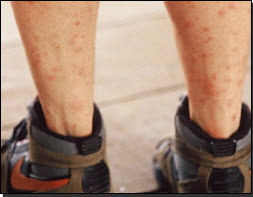 Mosquito Bites on Leg Source: Bed Bugs Handbook 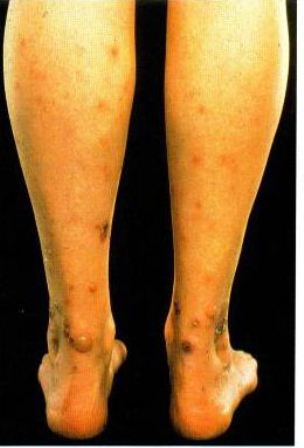 Picture Flea Bites on Leg Source: Bed Bugs Handbook 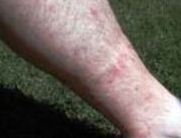 Chigger Bites Picture Source: Texas A&M |
Antihistamine, ice for swelling and itching. If symptoms get worse call your doctor. If you can’t breathe, have red and itchy bumps on your skin, dizziness or nausea, go to the ER |
| Irritant contact dermatitis | Skin exposure to chemicals | Scaly, red rash that starts after coming into contact with detergents, clothing, perfume, lotions, jewelry etc. Usually seen on arms and hands. | Don’t touch and avoid what you feel caused the problem. Try natural remedies or hydrocortisone cream. |
| Jock itch (Tinea cruris) | Fungus | Affects the groin
area in men. Presents as a red itchy
rash Picture of Jock Itch |
Over-the-counter antifungal cream, or jock itch remedies.. |
| Lupus erythematosus | Disease of the connective tissues | Achy joints and a red, butterfly shaped rash on the forehead and cheeks | Treatment depends on symptoms. Doctor will select appropriate regime |
| Measles | Virus | Fever,
sore throat, rashy red bumps or face and forehead,
which spread downward to cover the rest of your body. Spots on skin caused by the measles virus (Morbillivirus or Rubeola). Source: CDC/Brian W.J. Mahy BSC, PhD |
Mostly supportive
care is needed. Keep child away from others and particularly pregnant
women. Discuss options with doctor. |
| Molluscum Contagiosum |
Skin Infection due to virus |
Molluscum Contagiosum is spread
via a virus. it is common in children, athletes and adults that are
sexually active. |
In people with normal immune
systems, the problem can go away on its
own in months or years. Laser treatment and other Dermatologist
administered approaches are available. There is also a natural tpical
that treats the condition formulated by Naturasil. |
| Pityriasis rosea | Unknown | Starts
with scaly, red and itchy solo spot, but
spreads within days to other patches of red or tan col.ored rash on
your
chest, back and abdomen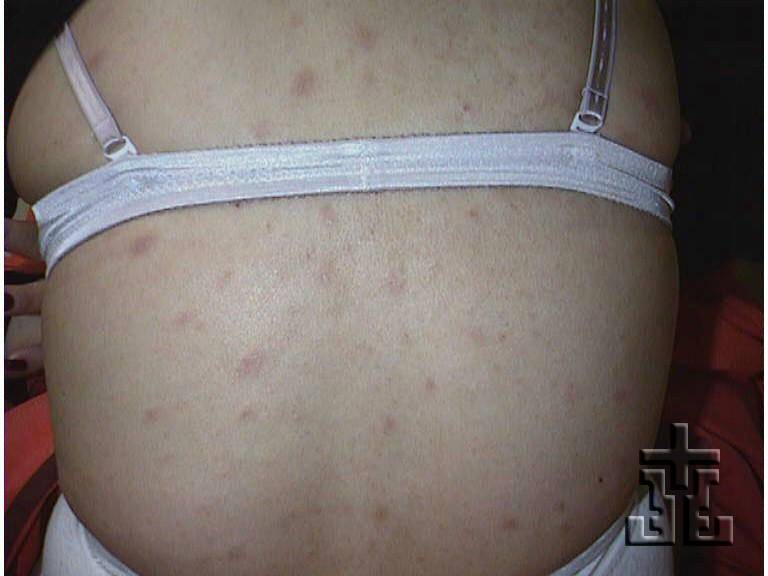 Source: ADES |
This skin disease typically doesn’t respond to treatments, and the rash may go away on its own in a few weeks. Try calamine lotion and antihistamines for itching/redness. |
| Psoriasis | Unknown, possibly the immune system | Red,
very irritated and bumpy skin with a white scaly
rash, usually on the knees and elbows and fingers. Can also
appear on back of head and at the top of anus. Source: Principles of Pediatric Dermatology |
Ointments, homeopathic remedies such as Skin Dr., oral medications and/or light therapy |
| Ringworm | Skin fungus | Rings of itchy, red
skin anywhere on your body Rinworm fungal rash on child Source: Principles of Pediatric Dermatology |
Antifungal cream and/or natural remedies. |
| Rocky mountain spotted fever | Bacterial infection from ticks | Red
rash started on legs and arms, spread to soles of feet and palms of
hand and comes with a headache and fever. Spots on skin from Rocky Mountain spotted fever. The condition is caused by a bacteria spread by ticks (Rickettsia rickettsiii) Source: CDC |
Antibiotic of choice of doctor i.e. tetracycline or doxycycline |
| Rosacea | Unknown | Cheeks,
chin, forehead and nose appear flushed Source: ADES |
No treatment usually needed, unless it is a bad rash. Homeopathic remedies such as RosaRex may help to reduce redness. Doctor will prescribe antibiotics if required |
| Scabies | Mites | Zigzag
shaped welts, red, extremely itchy, sores on just
about any location of your body. |
You will need prescription medication or natural remedies. Wash clothing and bed coverings in the hottest water possible |
| Seborrheic dematitis | Unknown, possibly a yeast infect ion that originates in hair follicles | Itchy,
red, scaly and oily rash around your nose, at the edge of your scalp or
in your eyebrows. Can also appear between the breasts. Man with Seborrheic dematitis that was originally mis-diagnosed as syphilis Source: CDC/Susan Linksley |
Hydrocortisone cream/selenium sulfide shampoo or natural remedies. See your doctor if the symptoms spread |
| Shingles | Reactivated chicken pox virus. Could be triggerred by stress or a depressed immune sytem | Painful
red blisters that may crust over |
Cool compresses. Supportive care with acetaminophen or ibuprofen. Natural remedies that contain plant extracts or L-Lysine. |
| Syphilis | Bacteria called a spirochete | One
of the few non-itchy rashes. Red and spreads to the genitals, rectal
areas, the
soles of your feet and/or the palms or your hands. Skin rash
can spread to other areas. Other syphillis symptoms that may
occur include fever, sore throat, patchy hair loss, headaches, weight
loss, muscle ache and fatigue. Spots on skin covering the soles of the feet due to a secondary Syphilis infection. Rash can appear as the condition is healing. Source: CDC |
See doctor immediately. Doctor will prescribe treatment needed which may include penicillin or other antibiotics. |
| Tinea Barbae (Barbers Itch or Face Ringworm) | Fungus | Redness and bumps
around the edges of the beard or on face.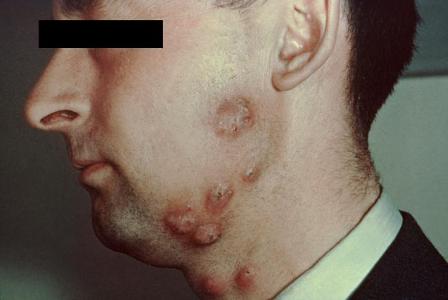 Spots on skin caused by the ringworm fungus, also referred to as Tinea Barbae or Barber's Itch. Source: CDC |
Can heal on it's own. |
| Tinea Versicolor (white spots on skin) | Fungal skin infection | Discolored
skin patches that may range from light
to dark. Often the cause for white skin spots. |
Homeopathic topical and soap, Selenium sulfide or antifungal cream. |
| Vitiligo | Inherited skin condition | Skin patches that
have lost color or pigmentation. Skin patches appear as white
skin spots or
pale. The condition is not contagious. Loss of pigmentation on the skin is called Vitiligo. Source: Orlando Skin Dog |
No treatment is needed In rare cases could be due to an underlying disease such as diabetes or thyroid disease.. Laser treatments are available but may or may not be successful. |
If you see your spots on skin condition worsening over time, be sure to see a Doctor who can best identify you specific condition.
Skin Cancer Spots
Skin Cancer Pictures

Whenever you see changes on the skin, or spots that look like these pictures, see a Doctor. When diagnosed early, most types of skin cancer can be easily treated.
Examples of Skin Cancer: Melanoma and Carcinoma

Types of Cancerous Skin Spots
Nodular melanoma
- Quick growth
- Different appearance than melanoma. Even color and raised from skin
- Color ranges from black, brown, pink or red.
- Shaped like a dome
- Firm when touched
- Over time can crust and bleed
Basal Cell Carcinoma
- Common type of skin cancer, not as dangerous as other forms
- Colors range from pearly, pale or red
- Appearance can be scaly, dry or a bump/lump
- May not heal or can ulcerate
- Slow growth, particularly in sun exposed areas.
Squamous cell carcinoma
- Can easily bleed
- Thick red scaly spot, can ulcerate or crust
- Growth occurs over months, often on sun exposed areas
- Higher incidence in people over 50 years of age
Brochures
References
The Johns Hopkins Complete Home Guide to Symptoms and Remedies
Symptoms
Isadore Rosenfeld, MD
Date Published: 2015-12-13
